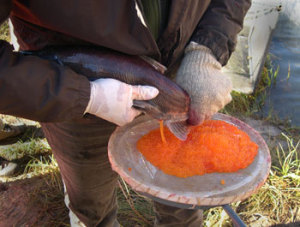Post
Two kokanee salmon spawning runs
Regional Fishing, United States Fishing Articles, Utah Fishing Articles | Utah theangler PM

Flaming Gorge anglers could see a nice bonus in future years after kokanee salmon ran up Sheep Creek this past October.
Two kokanee salmon spawning runs happened in Sheep Creek this fall, one in September and one in late October. The two runs provided biologists with plenty of kokanee salmon eggs.
The eggs the biologists obtained will be hatched in Utah’s hatchery system, and the fingerling salmon will be returned to Sheep Creek next spring.
Sheep Creek is a tributary to Flaming Gorge Reservoir. The reservoir is in northeastern Utah.
166,000 eggs
Lowell Marthe, aquatic biologist with the Utah Division of Wildlife Resources, says there are two strains of kokanee salmon. One strain spawns earlier in the fall, and one spawns later.
“We were planning to stock kokanee salmon into Sheep Creek that spawn later in the fall. Those fish would give us another opportunity to collect eggs,” Marthe says. “Nature helped us out this year, though, and provided us with an excellent run on its own. We collected about 166,000 eggs [in late October].”
“We collected and stripped eggs from more than 100 females,” says Dana Dewey, Whiterocks State Fish Hatchery manager. “We collected roughly 166,000 eggs, and the eggs looked exceptional: they were nice, big, healthy eggs.”
In 2000 and 2001, biologists noticed that some of the kokanee that usually did their late-fall spawning in Flaming Gorge Reservoir started spawning in Sheep Creek.
Since 2000, the intensity of this late-fall run has varied. Some years, only a few fish spawn in Sheep Creek. Other years, many fish spawn.
In 2004, the Wyoming Game and Fish Department also stocked late-spawning salmon into Henry’s Fork, a tributary to Flaming Gorge in Wyoming. Those fish ran up Henry’s Fork last year.
As they made plans for this year, DWR and WGFD biologists thought Henry’s Fork would have the better spawn, so they set traps to collect fish from the river for an egg take. As DWR biologists journeyed past Sheep Creek after checking empty traps in Henry’s Fork, they noticed how many fish had entered Sheep Creek.
“We saw a nice run of kokanee conveniently trapped by a beaver dam just a few hundred yards above the reservoir,” Marthe says. “These fish looked like they were ready to spawn, so we made some quick phone calls and pulled a multi-agency crew together. We got additional help from the U.S. – Fish and Wildlife Service and the U.S. – Forest Service, as well as from DWR biologists from the Whiterocks hatchery and our office in Vernal.”
In the past, biologists didn’t worry much about collecting and hatching eggs to raise kokanee that could be stocked into Flaming Gorge. The kokanee that were spawning in the reservoir and its tributaries provided enough reproduction to keep the population going.
But that may have changed.
“Our hydroacoustic surveys indicate the number of kokanee in Flaming Gorge is declining,” Marthe says. “We think predation by lake trout and burbot is the reason.”
Burbot were illegally introduced several years to waters in western Wyoming. After they were illegally stocked, they moved down the Green River and into Flaming Gorge. Now they’ve made their way down the reservoir, and biologists are finding them in areas where kokanee and lake trout spawn.
“Burbot are voracious predators, and they’re very good at feeding on whatever is near the bottom,” Marthe says. “While the effect they might be having on the kokanee population is still unclear, we know from stomach sampling that they’re definitely eating kokanee eggs. They’re even eating some 8- to 9-inch kokanee.
“Our management plan calls for us to eventually stock up to 2 million kokanee in the reservoir to try and reduce the drop in the population.”
“Over the last few years, we’ve taken eggs from salmon in Strawberry Reservoir. These salmon run earlier in the fall. We’ve hatched those eggs and stocked the fish into Sheep Creek to re-establish the four-year spawning run cycles,” Marthe says. “These early-run fish are descendants of the fish that originally spawned in Sheep Creek. ” Soon after we established these kokanee in Strawberry, the source for the kokanee was almost wiped out by a series of mud flows down Sheep Creek, and from increased predation. Now we’re bringing a few salmon back from Strawberry to supplement the surviving salmon that spawn in Sheep Creek. We also want to increase the size of the kokanee population that spawns in Sheep Creek so we can take more eggs in the future.”
Marthe says kokanee in Strawberry aren’t always consistent. Some of the yearly spawning runs at Strawberry are larger than others. Lake and stream conditions and the weather also play a role in how many fish the biologists catch each fall. For these reasons, efforts to gather fish from Strawberry Reservoir don’t always produce the number of kokanee salmon eggs that are needed.
“By having another kokanee run at Sheep Creek, we can supplement our main effort at Strawberry,” Marthe says. “This later run will keep our options open and create more opportunities to enhance the kokanee population in the Gorge.”
